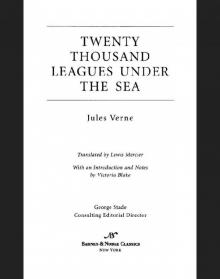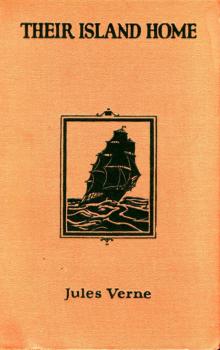- Home
- Jules Verne
The English at the North Pole Page 6
The English at the North Pole Read online
Page 6
CHAPTER VI
THE GREAT POLAR CURRENT
A short time after the flights of birds became more and more numerous.Petrels, puffins, and mates, inhabitants of those desolate quarters,signalled the approach of Greenland. The _Forward_ was rapidlynearing the north, leaving to her leeward a long line of black smoke.
On Tuesday the 17th of April, about eleven o'clock in the morning,the ice-master signalled the first sight of the ice-blink; it wasabout twenty miles to the N.N.W. This glaring white strip wasbrilliantly lighted up, in spite of the presence of thick clouds inthe neighbouring parts of the sky. Experienced people on board couldmake no mistake about this phenomenon, and declared, from itswhiteness, that the blink was owing to a large ice-field, situatedat about thirty miles out of sight, and that it proceeded from thereflection of luminous rays. Towards evening the wind turned roundto the south, and became favourable; Shandon put on all sail, andfor economy's sake caused the fires to be put out. The _Forward_,under her topsails and foresails, glided on towards Cape Farewell.
At three o'clock on the 18th they came across the ice-stream, anda white thick line of a glaring colour cut brilliantly the lines ofthe sea and sky. It was evidently drifting from the eastern coastof Greenland more than from Davis's Straits, for ice generally keepsto the west coast of Baffin's Sea. An hour afterwards the _Forward_passed in the midst of isolated portions of the ice-stream, and inthe most compact parts, the icebergs, though welded together, obeyedthe movements of the swell. The next day the man at the mastheadsignalled a vessel. It was the _Valkirien_, a Danish corvette, runningalongside the _Forward_, and making for the bank of Newfoundland.The current of the Strait began to make itself felt, and Shandon hadto put on sail to go up it. At this moment the commander, the doctor,James Wall, and Johnson were assembled on the poop examining thedirection and strength of the current. The doctor wanted to know ifthe current existed also in Baffin's Sea.
"Without the least doubt," answered Shandon, "and the sailing vesselshave much trouble to stem it."
"Besides there," added Wall, "you meet with it on the eastern coastof America, as well as on the western coast of Greenland."
"There," said the doctor, "that is what gives very singular reasonto the seekers of the North-West passage! That current runs aboutfive miles an hour, and it is a little difficult to suppose that itsprings from the bottom of a gulf."
"It is so much the more probable, doctor," replied Shandon, "thatif this current runs from north to south we find in Behring's Straitsa contrary current which runs from south to north, and which mustbe the origin of this one."
"According to that," replied the doctor, "we must admit that Americais totally unconnected with the Polar lands, and that the waters ofthe Pacific run round the coasts of America into the Atlantic. Onthe other hand, the greater elevation of the waters of the Pacificgives reason to the supposition that they fall into the Europeanseas."
"But," sharply replied Shandon, "there must be facts to establishthat theory, and if there are any," added he with irony, "ouruniversally well-informed doctor ought to know them."
"Well," replied the above-mentioned, with amiable satisfaction, "ifit interests you, I can tell you that whales, wounded in Davis'sStraits, are caught some time afterwards in the neighbourhood ofTartary with the European harpoon still in their flanks."
"And unless they have been able to double Cape Horn or the Cape ofGood Hope," replied Shandon, "they must necessarily have rounded theseptentrional coasts of America--that's what I call indisputable,doctor."
"However, if you were not convinced, my dear fellow," said the doctor,smiling, "I could still produce other facts, such as drift-wood, ofwhich Davis's Straits are full, larch, aspen, and other tropical trees.Now we know that the Gulf Stream hinders those woods from enteringthe Straits. If, then, they come out of it they can only get in fromBehring's Straits."
"I am convinced, doctor, and I avow that it would be difficult toremain incredulous with you."
"Upon my honour," said Johnson, "there's something that comes justin time to help our discussion. I perceive in the distance a lumpof wood of certain dimensions; if the commander permits it we'll haulit in, and ask it the name of its country."
"That's it," said the doctor, "the example after the rule."
Shandon gave the necessary orders; the brig was directed towards thepiece of wood signalled, and soon afterwards, not without trouble,the crew hoisted it on deck. It was the trunk of a mahogany tree,gnawed right into the centre by worms, but for which circumstanceit would not have floated.
"This is glorious," said the doctor enthusiastically, "for as thecurrents of the Atlantic could not carry it to Davis's Straits, andas it has not been driven into the Polar basin by the streams ofseptentrional America, seeing that this tree grew under the Equator,it is evident that it comes in a straight line from Behring; and lookhere, you see those sea-worms which have eaten it, they belong toa hot-country species."
"It is evident," replied Wall, "that the people who do not believein the famous passage are wrong."
"Why, this circumstance alone ought to convince them," said thedoctor; "I will just trace you out the itinerary of that mahogany;it has been floated towards the Pacific by some river of the Isthmusof Panama or Guatemala, from thence the current has dragged it alongthe American coast as far as Behring's Straits, and in spite ofeverything it was obliged to enter the Polar Seas. It is neither soold nor so soaked that we need fear to assign a recent date to itssetting out; it has had the good luck to get clear of the obstaclesin that long suite of straits which lead out of Baffin's Bay, andquickly seized by the boreal current came by Davis's Straits to bemade prisoner by the _Forward_ to the great joy of Dr. Clawbonny,who asks the commander's permission to keep a sample of it."
"Do so," said Shandon, "but allow me to tell you that you will notbe the only proprietor of such a wreck. The Danish governor of theIsle of Disko----"
"On the coast of Greenland," continued the doctor, "possesses amahogany table made from a trunk fished up under the samecircumstances. I know it, but I don't envy him his table, for if itwere not for the bother, I should have enough there for a wholebedroom."
During the night, from Wednesday to Thursday, the wind blew withextreme violence, and driftwood was seen more frequently. Nearingthe coast offered many dangers at an epoch in which icebergs wereso numerous; the commander caused some of the sails to be furled,and the _Forward_ glided away under her foresail and foremast only.The thermometer sank below freezing-point. Shandon distributedsuitable clothing to the crew, a woollen jacket and trousers, aflannel shirt, wadmel stockings, the same as those the Norwegiancountry-people wear, and a pair of perfectly waterproof sea-boots.As to the captain, he contented himself with his natural fur, andappeared little sensible to the change in the temperature; he had,no doubt, gone through more than one trial of this kind, and besides,a Dane had no right to be difficult. He was seen very little, as hekept himself concealed in the darkest parts of the vessel.
Towards evening the coast of Greenland peeped out through an openingin the fog. The doctor, armed with his glass, could distinguish foran instant a line of peaks, ridged with large blocks of ice; but thefog closed rapidly on this vision, like the curtain of a theatrefalling in the most interesting moment of the piece.
On the morning of the 20th of April the _Forward_ was in sight ofan iceberg a hundred and fifty feet high, stranded there from timeimmemorial; the thaws had taken no effect on it, and had respectedits strange forms. Snow saw it; James Ross took an exact sketch ofit in 1829; and in 1851 the French lieutenant Bellot saw it from thedeck of the _Prince Albert_. Of course the doctor wished to keep amemento of the celebrated mountain, and made a clever sketch of it.It is not surprising that such masses should be stranded and adhereto the land, for to each foot above water they have two feet below,giving, therefore, to this one about eighty fathoms of depth.
At last, under a temperature which at noon was only 12 degrees, undera snowy and foggy sky, Cape Fare
well was perceived. The _Forward_arrived on the day fixed; if it pleased the unknown captain to comeand occupy his position in such diabolical weather he would have nocause to complain.
"There you are, then," said the doctor to himself, "cape so celebratedand so well named! Many have cleared it like us who were destinednever to see it again. Is it, then, an eternal adieu said to one'sEuropean friends? You have all passed it. Frobisher, Knight, Barlow,Vaughan, Scroggs, Barentz, Hudson, Blosseville, Franklin, Crozier,Bellot, never to come back to your domestic hearth, and that capehas been really for you the cape of adieus."
It was about the year 970 that some navigators left Iceland anddiscovered Greenland. Sebastian Cabot forced his way as far aslatitude 56 degrees in 1498. Gaspard and Michel Cotreal, in 1500 and1502, went as far north as 60 degrees; and Martin Frobisher, in 1576,arrived as far as the bay that bears his name. To John Davis belongsthe honour of having discovered the Straits in 1585; and two yearslater, in a third voyage, that bold navigator and great whaler reachedthe sixty-third parallel, twenty-seven degrees from the Pole.
Barentz in 1596, Weymouth in 1602, James Hall in 1605 and 1607, Hudson,whose name was given to that vast bay which hollows out so profoundlythe continent of America, James Poole, in 1611, advanced far intothe Strait in search of that North-West passage the discovery of whichwould have considerably shortened the track of communication betweenthe two worlds. Baffin, in 1616, found the Straits of Lancaster inthe sea that bears his own name; he was followed, in 1619, by JamesMunk, and in 1719 by Knight, Barlow, Vaughan, and Scroggs, of whomno news has ever been heard. In 1776 Lieutenant Pickersgill, sentout to meet Captain Cook, who tried to go up Behring's Straits, reachedthe sixty-eighth degree; the following year Young, for the samepurpose, went as far north as Woman's Island.
Afterwards came Captain James Ross, who, in 1818, rounded the coastsof Baffin's Sea, and corrected the hydrographic errors of hispredecessors. Lastly, in 1819 and 1820, the celebrated Parry passedthrough Lancaster Straits, and penetrated, in spite of unnumbereddifficulties, as far as Melville Island, and won the prize of 5,000pounds promised by Act of Parliament to the English sailors who wouldreach the hundred and seventeenth meridian by a higher latitude thanthe seventy-seventh parallel.
In 1826 Beechey touched Chamisso Island; James Ross wintered from1829 to 1833 in Prince Regent Straits, and amongst other importantworks discovered the magnetic pole. During this time Franklin, byan overland route, traversed the septentrional coasts of America fromthe River Mackenzie to Turnagain Point. Captain Back followed in hissteps from 1823 to 1835, and these explorations were completed in1839 by Messrs. Dease and Simpson and Dr. Rae.
Lastly, Sir John Franklin, wishing to discover the North-West passage,left England in 1845 on board the _Erebus_ and the _Terror_; hepenetrated into Baffin's Sea, and since his passage across DiskoIsland no news had been heard of his expedition.
That disappearance determined the numerous investigations which havebrought about the discovery of the passage, and the survey of thesePolar continents, with such indented coast lines. The most daringEnglish, French, and American sailors made voyages towards theseterrible countries, and, thanks to their efforts, the maps of thatcountry, so difficult to make, figured in the list of the RoyalGeographical Society of London. The curious history of thesecountries was thus presented to the doctor's imagination as he leanedon the rail, and followed with his eyes the long track left by thebrig. Thoughts of the bold navigators weighed upon his mind, and hefancied he could perceive under the frozen arches of the icebergsthe pale ghosts of those who were no more.

 Michael Strogoff; Or the Courier of the Czar: A Literary Classic
Michael Strogoff; Or the Courier of the Czar: A Literary Classic Voyage au centre de la terre. English
Voyage au centre de la terre. English Journey Through the Impossible
Journey Through the Impossible The Castaways of the Flag
The Castaways of the Flag L'île mystérieuse. English
L'île mystérieuse. English Maître du monde. English
Maître du monde. English Around the World in Eighty Days
Around the World in Eighty Days A Voyage in a Balloon
A Voyage in a Balloon From the Earth to the Moon, Direct in Ninety-Seven Hours and Twenty Minutes: and a Trip Round It
From the Earth to the Moon, Direct in Ninety-Seven Hours and Twenty Minutes: and a Trip Round It Paris in the Twentieth Century
Paris in the Twentieth Century City in the Sahara - Barsac Mission 02
City in the Sahara - Barsac Mission 02 The English at the North Pole
The English at the North Pole The Field of Ice
The Field of Ice From the Earth to the Moon
From the Earth to the Moon Un capitaine de quinze ans. English
Un capitaine de quinze ans. English The Mysterious Island
The Mysterious Island Les indes-noirs. English
Les indes-noirs. English Robur-le-conquerant. English
Robur-le-conquerant. English Propeller Island
Propeller Island Around the World in Eighty Days. Junior Deluxe Edition
Around the World in Eighty Days. Junior Deluxe Edition Les forceurs de blocus. English
Les forceurs de blocus. English In the Year 2889
In the Year 2889 Journey to the Centre of the Earth
Journey to the Centre of the Earth Twenty Thousand Leagues Under the Sea
Twenty Thousand Leagues Under the Sea From the Earth to the Moon; and, Round the Moon
From the Earth to the Moon; and, Round the Moon Vingt mille lieues sous les mers. English
Vingt mille lieues sous les mers. English Cinq semaines en ballon. English
Cinq semaines en ballon. English Twenty Thousand Leagues under the Seas
Twenty Thousand Leagues under the Seas Face au drapeau. English
Face au drapeau. English Michael Strogoff; Or, The Courier of the Czar
Michael Strogoff; Or, The Courier of the Czar Un billet de loterie. English
Un billet de loterie. English The Secret of the Island
The Secret of the Island Off on a Comet! a Journey through Planetary Space
Off on a Comet! a Journey through Planetary Space Into the Niger Bend: Barsac Mission, Part 1
Into the Niger Bend: Barsac Mission, Part 1 All Around the Moon
All Around the Moon A Journey to the Center of the Earth - Jules Verne: Annotated
A Journey to the Center of the Earth - Jules Verne: Annotated 20000 Lieues sous les mers Part 2
20000 Lieues sous les mers Part 2 Robur-le-Conquerant
Robur-le-Conquerant Les Index Noires
Les Index Noires Michael Strogoff; or the Courier of the Czar
Michael Strogoff; or the Courier of the Czar 20000 Lieues sous les mers Part 1
20000 Lieues sous les mers Part 1 Twenty Thousand Leagues Under the Sea (Barnes & Noble Classics Series)
Twenty Thousand Leagues Under the Sea (Barnes & Noble Classics Series) Five Weeks In A Balloon
Five Weeks In A Balloon Journey to the Center of the Earth
Journey to the Center of the Earth 20,000 Leagues Under the Sea
20,000 Leagues Under the Sea Journey to the Center of the Earth (Barnes & Noble Classics Series)
Journey to the Center of the Earth (Barnes & Noble Classics Series) Adrift in the Pacific-Two Years Holiday
Adrift in the Pacific-Two Years Holiday The Collected Works of Jules Verne: 36 Novels and Short Stories (Unexpurgated Edition) (Halcyon Classics)
The Collected Works of Jules Verne: 36 Novels and Short Stories (Unexpurgated Edition) (Halcyon Classics) The Survivors of the Chancellor
The Survivors of the Chancellor Their Island Home
Their Island Home Le Chateau des Carpathes
Le Chateau des Carpathes Les Cinq Cents Millions de la Begum
Les Cinq Cents Millions de la Begum The Floating Island
The Floating Island Cinq Semaines En Ballon
Cinq Semaines En Ballon Autour de la Lune
Autour de la Lune